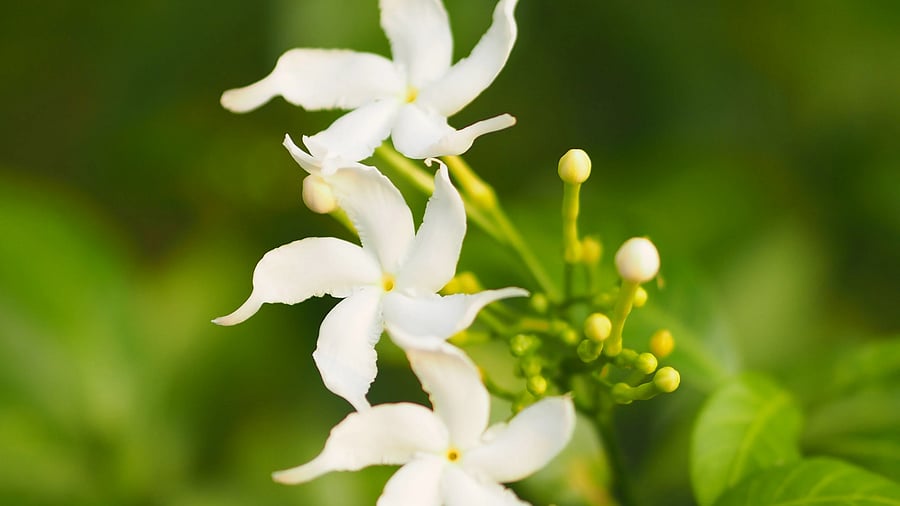
The beautiful crepe jasmine.
I was working in the living room when I heard the gate open. There was no knock or call, just the faint rustle of movement outside. I stepped out to see a woman near the Nandibatlu (Crepe jasmine) shrub next to the gate, gathering flowers with quiet efficiency.
Tabernaemontana divaricata, also called Nandibatlu, Nandiyavattai, Chandni, Crepe Jasmine or Moonbeam, stood in full bloom, its white pinwheel flowers bright against glossy green leaves. The ground beneath it was carpeted in white.
The lady was short and frail. She carried a striped plastic bag already filled with flowers, yellow oleanders among them. She glanced at me once, said the flowers were for her pooja, and returned to her task. For someone so slight, she moved with surprising speed and determination, as if the flowers might vanish if she slowed down.
I stood there watching her strip the branches bare. After a while, she looked up and asked if I could get her a stool. I thought she wanted to sit, perhaps worn out from her plucking spree. But she said she wanted it to reach the flowers on the top branches! I was taken aback. I told her she couldn’t take any more flowers and suggested she grow her own, even offered her a cutting. My voice wasn’t raised, but it was firm. I was more amused than angry. She paused, gave me a look, and then left without a word of thanks. It struck me that she believed the flowers were hers to take!
That day stayed with me, though the scene was a familiar one. Our Nandibatlu has seen many such visitors. Some would slip in after the lights go out in our house to gather flowers, and others would appear at dawn. The plant was generous to everyone, yet it was so often handled roughly. Branches were yanked down with sticks, pulled until they bent or broke. And then one morning, someone tugged at the main stem until it split into two. The plant never recovered, and within weeks it was gone.
I wonder if the one who broke it ever felt guilty, knowing how a single tug undid years of care. Yet guilt seems almost beside the point when such behaviour is so widespread, when plants are treated as though they cannot be harmed at all.
In our social media age, where every beautiful flower becomes a ‘must-have’ moment, the line between admiring and claiming has blurred completely. I’ve seen people photograph plants in parks and along roadsides, only to return with pruning shears to snip them off for social media ‘likes.’ The irony is that those who rip off are the least likely to grow what they’ve taken. A plant adapted to the sidewalk rarely survives once torn from its place. With most of its roots gone, it struggles and usually withers.
When we normalise this kind of behaviour, we lose something essential about community respect. Every garden, no matter how small, represents someone’s faith in tomorrow: seeds planted out of love, watered through dry spells, protected through storms, and cherished at first bloom. When we take without asking, we’re not just taking flowers; we’re taking a piece of faith away from them.
Perhaps if that woman in the green saree had asked, I might have gladly picked flowers for her myself, or shown her which ones to take. Instead, her quiet assumption that the flowers were simply there for the taking left me wondering. Generosity, I’ve learned, has limits, even in the garden.
Motley Garden is your monthly kaleidoscopic view into a sustainable garden ecosystem. The author believes gardens are shared spaces where plants and creatures thrive together.
Reader query
Even in our own homes, care often comes down to simple attentiveness. Suma sent me a photo of her Jade plant, a small-leaved variety, asking why it was shedding leaves. The plant was on a centre table inside the house, far from any sunlight.
This is a common mistake. A “houseplant” doesn’t mean it can live without light. It only means it can tolerate lower levels compared to outdoor plants. Jade still needs bright, indirect sunlight through the day. Leaf drop usually happens because of overwatering, poor drainage, or stress. Repot it in fresh soil, water only when it wilts and shift it to a brighter spot. With some care, it should recover.
Share your stories and plant queries at @allthingsinmygarden. Together, we can grow a community of gardeners.